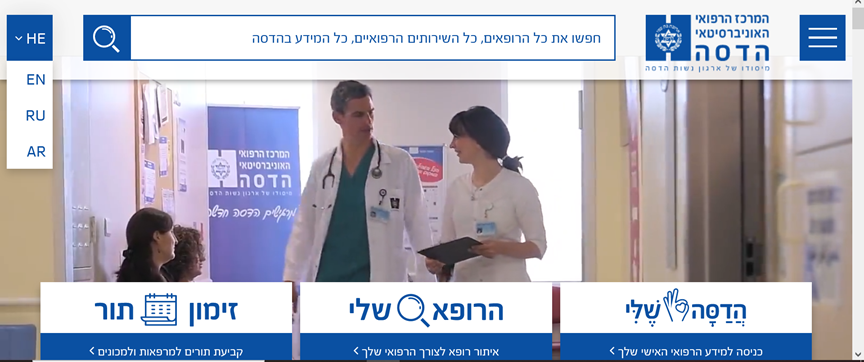The language of health
By Maya De Vries Kedem, on 19 July 2021
By Maya de Vries and Laila Abed Rabho

Person typing on a hospital computer next to a stethoscope. Source: Unsplash
In the meetings that we held with women in Dar al-Hawa, we found that most of them were suffering from various health problems, the most common ones being high blood stress, diabetes, back, and leg pain. When going to one of the local public health clinics in Dar al-Hawa, clinics that are managed by local Palestinians as well as subsidised by the Israeli Ministry of Health, they are likely to get good quality treatment both in terms of their health problem as well as in terms of their own understanding of the process, as these clinics operate in Arabic.
However, the situation is much less convenient when they are required to visit one of the Israeli hospitals in Jerusalem to receive treatment – not because they will not be seen for their health problem or accepted as patients, but rather, in their own words, will not be able to understand large parts of what is being said to them by doctors, nurses and other staff. Sitting in a doctor’s office or treatment room is a stressful situation can be a stressful situation regardless of the health issue that is being investigated. When the issue of a language barrier between the patient and healthcare staff is added to the equation, the patient(s), in this case, older Palestinian women, can be made to feel even more uncomfortable as he/she is required to seek help with translation.
Hospitals are highly stressful places where many types of individuals (whether patients or staff) belonging to a variety of social groups intersect on a daily basis. These meetings can constitute points of friction or moments of acquaintance between groups of people who may ordinarily be fairly indifferent to each other. In al-Quds, Israeli hospitals, this tension between Jews and Arabs has existed for many years, as we found out from some of the women we spoke to in Dar al-Hawa. One expression of this tension is the absence of the Arabic language from the hospital space.
This situation makes the women of Dar al-Hawa more dependent, as patients, than they already are: presently, most of them have to rely on either their husband, their children, or their grandchildren to accompany them to the hospital, or on a translator provided by the hospital – usually, there is only one on the ward. There is also the possibility that an Arabic-speaking doctor or a nurse may be around to facilitate translation, but this is not certain. What does make the experience a bit easier is the fact that all signs at the hospital are usually written in Hebrew, English, and Arabic. However, our participants told us that this is not going far enough – something that even the women in our group who do speak Hebrew agree with.
Dina, 58, remembers her period of hospitalisation:
“I stayed in the hospital for some time, they used to give lectures in Hebrew, I hope they bring doctors that give lectures in Arabic, because there were Arab patients who had had an open heart surgery but did not show up to the lectures because they didn’t understand Hebrew, many Arabs don’t understand Hebrew, or they do, but not to the extent that that they are able to answer the nurses.”
Sireen, 42, adds that other than the language barrier, she does not have any complaints about the hospital:
”I usually don’t go to hospitals; I used to go the hospital just to give birth. Honestly, during the period that I was in hospital, I felt that the staff and the service in the hospital was very good, I didn’t face any problems except for the language.”
On the other hand, Nasreen, who is 76 and speaks good Hebrew, recalls seeing people her age struggling whilst in hospital:
“I understand, read and write Hebrew. Other people who come to the hospital and do not know Hebrew bring people with them to help them and translate for them, it’s hard that they don’t give information in Arabic.”
Mona, a 60-year-old research participant, described the language problem in a more nuanced way, stating:
“Since we are treated at Israeli hospitals and the language that is used is Hebrew, sometimes I can’t communicate with them [doctors] or understand what they are saying, if there is someone that can translate that can help…or if the information is written in Arabic, all the medication package inserts are written both in Arabic and Hebrew, but in the hospitals, not everything is written in Arabic.”
Taking into account the stories told to us by our participants, we think that the language gap points to a more fundamental, less spoken-about problem: that of racism. Even though the issue of racism is familiar to the Ministry of Health and there is an official protocol that aims to reduce racism against patients and healthcare staff within the hospital[i], the women we spoke to think this is still an issue. Rabab, 63, says:
“I want them to treat me like any other person, I don’t want them to underestimate me, we are exposed to racism in the Israeli hospitals. For me, Hebrew is an obstacle, when I visit the doctor, I take my sisters or my children with me so they can translate. I would prefer if everything will be in Arabic. Once, my husband felt pain in his eyes so we went to Shaare Zedek medical center, I heard the doctors speak, they said that there is no ‘use’ to his eyes , so I told him in Hebrew that I didn’t understand what he meant, he answered <<you don’t live in Iraq, you live in Israel, so you must learn Hebrew>>. I wrote a complaint and sent it to the hospital.”
Reem, a 50-year-old participant, talks about her experience in a maternity department in an Israeli hospital:
“We saw there were volunteers who came to help Jewish women and teach them how to breastfeed. We did not see anyone who spoke Arabic. There is a shortage of volunteers who do such work for Arabs, and even the Arabic language was not spoken. Only Hebrew.”
To conclude, our interviewees point to the importance of the language as an important parameter that should be taken into consideration in healthcare settings and when considering the quality of care, especially in al-Quds, where the public health system is fairly well-developed due to being part of the national Israeli health system. Treatment can and should be better when it comes to not just the medical treatment itself, but also the details of patients’ symptoms and the diagnosis. In order to get a comprehensive and accurate picture of a patient’s medical problem and decide on the best course of action in terms of care, it is very important to understand ‘the little details’, and for that to happen, understanding the spoken language of health at the point of care is a must.
Below, we show two examples of the home pages of two relevant, major hospitals in al-Quds, Hadassah Hospital and Sharee Zedek Hospital. Although both are available in Arabic, Hadassah’s home page only allows the user to select a different language if the user already speaks English – the different options for languages are written in English letters: ‘EN’, ‘AR’, ‘RU’. Sharee Zedek displays the different language options in the ‘mother tongue’ itself.

Pic 1: home page of Hadassah hospital. On the right side, visitors can choose between English, Hebrew, Arabic, or Russian – but the language menu itself is in English (written in English characters).

The home page of Sharee Zedek hospital: on the right-hand side, website visitors can choose their choose language, with the choices being English, Russian or Arabic. Although written in a small font size, the choices are given in the mother tongue itself (I.e. using the Arabic alphabet), which makes it more accessible to non-Hebrew readers.
[i] see for example this page published in the website of the MOH: https://www.health.gov.il/English/Topics/Equality_in_Health/racism/Pages/default.aspx) See also an important article about separation in maternity departments: https://www.haaretz.com/israel-news/.premium-though-illegal-jewish-arab-segregation-plagues-israel-s-hospitals-1.6725140
 Close
Close






